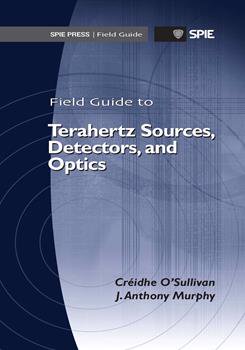|
|
BibliographyBoyd R. W., Nonlinear Optics, Academic Press, Waltham, MA
(2008). Google Scholar
Cunningham P. D., Valdes N. N., Vallejo F. A., Hayden L. M., Polishak B., Zhou X.-H., Luo J., Jen A. K.-Y., Williams J. C., Twieg R. J., ““Broadband terahertz characterization of the refractive index and absorption of some important polymeric and organic electro-optic materials,”,” J. Appl. Phys., 109 043505 (2011). Google Scholar
Dexheimer S., Terahertz Spectroscopy Principles and Applications, CRC Press, Boca Raton, FL
(2008). Google Scholar
Ferguson B., Zhang X.-C., ““Materials for terahertz science and technology,”,” Nature Mater., 1 26–35 (2002). Google Scholar
Goldsmith P. F., Quasioptical Systems: Gaussian beam quasioptical propagation and applications, Wiley–IEEE Press, Hoboken, NJ
(1998). Google Scholar
Irwin K. D., Hilton G. S., “Transition-edge sensors,” Cryogenic Particle Detection, 99 63–152 Springer–Verlag, Berlin
(2005). Google Scholar
Lee Y.-S., Principles of Terahertz Science and Technology, Springer, New York
(2009). Google Scholar
, Millimetre-Wave Optics, Devices and Systems, Taylor & Francis, London
(1990). Google Scholar
Martin D. H., Bowen J. W., ““Log-wave optics,”,” IEEE Trans. Microw. Theory Tech., 41 (10), 1676–1690 (1993). Google Scholar
Miles R. E., Harrison P., Lippens D., Terahertz Sources and Systems, Springer, New York
(2001). Google Scholar
Milligan T. A., Modern Antenna Design, Wiley–IEEE Press, Hoboken, NJ
(2005). Google Scholar
Mittleman D., Sensing with Terahertz Radiation, 85 Springer Series in Optical Sciences2002). Google Scholar
Murphy J. A., Egan A., Withington S., ““Truncation in millimeter and submillimeter-wave optical systems,”,” IEEE Trans. Antennas and Propag, 41 (10), 1408–1413 (1993). Google Scholar
Murphy J. A., Trappe N., Withington S., ““Gaussian beam mode analysis of partial reflections in simple quasi-optical systems fed by horn antennas,”,” Infrared Phys. Technol., 44 289–297 (2003). Google Scholar
Naftaly M., Miles R. E., ““Terahertz time-domain spectroscopy for material characterization,”,” Proc. IEEE, 95 (8), 1658–1665 (2007). Google Scholar
Olver A. D., Clarricoats P. J. B., Kishk A. A., Shafai I., Microwave Horns and Feeds, IEEE Press, New York
(1994). Google Scholar
O’Sullivan C., Atad-Ettedgui E., Duncan W., Henry D., Jellema W., Murphy J. A., Trappe N., van de Stadt H., Withington S., Yassin G., ““Far-IR optics design and verification,”,” Int. J. Infrared Milli, 23 1029–1045 (2002). Google Scholar
Rieke G. H., Detection of Light: From the Ultraviolet to the Submillimeter, Cambridge University Press, Cambridge
(1994). Google Scholar
Richards P. L., ““Bolometers for infrared and millimeter waves,”,” J. Appl. Phys., 76 1–24 (1994). Google Scholar
Rogalski A., Sizov F., ““Terahertz detectors and focal plane arrays,”,” Opto-Electron. Rev, 19 346–404 (2011). Google Scholar
Rostami A., Rasooli H., Baghban H., Terahertz Technology: Fundamentals and Applications, 77 Lecture Notes in Electrical Engineering, Springer, Berlin
(2011). Google Scholar
Sakai K., Terahertz Optoelectronics, 97 Topics in Applied Physics, Springer, Berlin
(2005). Google Scholar
Semenov A. D., Gol’tsman G. N., Sobolewski R., ““Hot-electron effect in superconductors and its applications for radiation sensors,”,” Supercond. Sci. Technol., 15 R1–R16 (2002). Google Scholar
Siegel P.H., ““Terahertz technology,”,” IEEE Trans. Microw. Tech., 50 910–928 (2002). Google Scholar
Siegman A. E., Lasers, University Science Books, Sausalito, CA
(1986). Google Scholar
Sizov F., ““THz radiation sensors,”,” Opto-Electron. Rev., 18 10–36 (2010). Google Scholar
Sze S. M., Ng K. K., Physics of Semiconductor Devices, John Wiley and Sons, Hoboken, NJ
(2007). Google Scholar
van der Valk N. C. J., Wenckebach T., Planken P. C. M., ““Full mathematical description of electro-optic detection in optically isotropic crystals,”,” J. Opt. Soc. Am. B, 21 3 (2004). Google Scholar
Van Rudd J., Mittleman D. M., ““Influence of substrate-lens design in terahertz time-domain spectroscopy,”,” J. Opt. Soc. Am. B, 19 319–329 (2002). Google Scholar
Zhang X.-C., ““Terahertz wave imaging: horizons and hurdles,”,” Phys. Med. Biol., 47 3667–3677 (2002). Google Scholar
Zhang X.-C., Xu J., Introduction to THz Wave Photonics, Springer, New York
(2009). Google Scholar
Zmuidzinas J., Richards P. L., ““Superconducting detectors and mixers for millimeter and submillimeter astrophysics,”,” Proc. IEEE, 92 1597–1616 (2004). Google Scholar
|
CITATIONS
Sensors
Diodes
Quantum efficiency
Signal to noise ratio
Superconductors
Terahertz sources
Beam shaping




